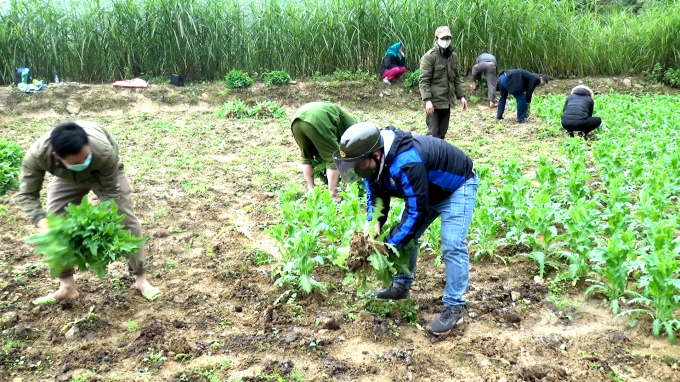November 26, 2025 | 05:33 GMT +7
November 26, 2025 | 05:33 GMT +7
Hotline: 0913.378.918
November 26, 2025 | 05:33 GMT +7
Hotline: 0913.378.918

Ha Giang province's functional forces destroying a large amount of poppy plants grown in households. Photo: TL.
On February 22, Vi Xuyen district police coordinated with Thuong Son commune authorities to destroy 3,765 poppy plants in the home garden of subject Hoang Thi Giang, Bo Dot village, Thuong Son commune, Vi Xuyen district, Ha Giang province.
These poppy plants were planted by Hoang Thi Giang in the family's garden from November 2021, with an area of 450m2, and are currently preparing to flower. Through investigation and verification by the police of Vi Xuyen district, Ha Giang province, Giang confessed that the purpose of growing poppy was to make medicine for the family, due to lack of knowledge, Giang planted them in the garden.
Currently, Ha Giang province's functional forces have made a record, handled the suspect and destroyed all of the poppy plants.
Translated by Nguyen Hai Long

(VAN) Deputy Minister Nguyen Quoc Tri emphasized the determination to prevent violations at CoP20, sharing enforcement results and commitments to strengthen cooperation with the international community in the coming period.

(VAN) In addition to strengthening the relationship between schools and enterprises, the Aus4Skills project expands opportunities for female students and people with disabilities to work in the transport and logistics sector.

(VAN) Nghe An is preparing policy, technical, and resource steps to participate in the forest carbon credit market.
/2025/11/25/1648-2-110733_532.jpg)
(VAN) From 2011 to 2023, Ca Mau province lost approximately 6,200 ha of coastal land and protection forests due to erosion, threatening many residential areas, infrastructure facilities, and production zones.

(VAN) Quang Ngai holds strong potential for carbon credits but needs a clear legal and policy framework to secure sustainable revenue from this resource.

(VAN) With its diverse ecosystem, Phu Quoc National Park plays a vital role in environmental protection and biodiversity conservation and serves as the core zone of the Kien Giang World Biosphere Reserve.

(VAN) Cooperation activities under the Aus4Skills program focus on: logistics professional development, competency-based training and assessment (CBTA), leadership innovation, and digitalization.